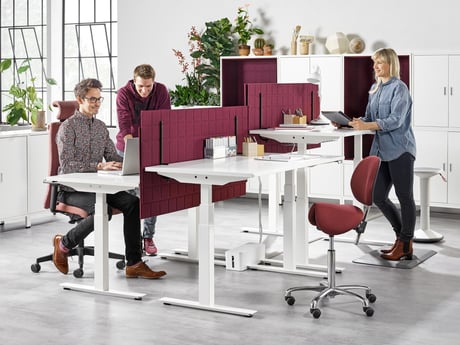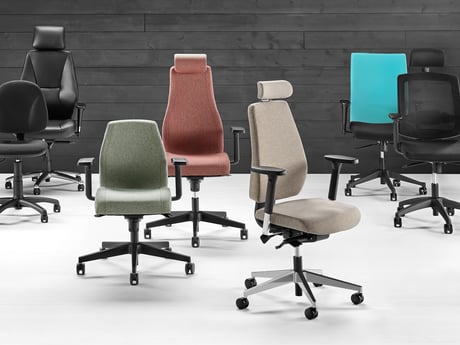How to feel at home in your office

The modern workplace is seeing a rising trend for blurring the lines between work and home. Technology has revolutionised the way we work both in the office and out of it. Thanks to smart devices, there is no reason that we have to be chained to our desks anymore. With a laptop, mobile phone and good Wi-Fi signal, most office workers can do their job from any location. This has led to far more flexibility in terms of our work environment, allowing employees to choose their workspace based on their current task or mood.
However, it does also put more demands on the workplace itself. Your office now needs to offer a variety of work areas and informal spaces to adapt to this new way of working.
A 2017 Gallup report showed that the most engaged employees spend 60-80% of their time working away from the office ¹. However, remote working doesn’t suit every member of staff or, indeed, every business. Bringing home to the office is a compromise that suits everyone.
So, what changes can you make to your office furniture and layout to make staff feel more at home?
Informal spaces
According to Steelcase, 40% of workers say they don’t have enough informal spaces in their workplace and, perhaps surprisingly, this was true across all age groups ².
Lounge spaces and dining areas give employees a space to collaborate and socialise. The more informal setting inspires greater levels of creativity and allows people from different teams to work together. Surprisingly, younger generations also find these spaces a great place for privacy and use them to sit alone, perhaps with headphones on, and focus. Casual workspaces that give employees the flexibility to work in the way that best suits them and their current work assignment are less stressful and boost productivity and teamwork – giving staff the best of both worlds: home and the office.
Home comforts
The office furniture you choose makes a huge difference to the atmosphere in your workplace. Furnish collaborative spaces with comfortable sofas and conveniently-placed coffee tables to make staff feel like they’re at home in their own living room. Make sure you have plenty of easily-accessible coffee machines and tea-making facilities around the office. Add rugs and lamps to make it feel even more homely.
Another thing to think about that makes a big difference is the dress code. Is there a real reason for staff to wear suits to the office? Wearing something you feel comfortable in can completely change your outlook and is one of the biggest differences between work and home. More and more companies are allowing employees to come to work in less formal clothes. Unless employees have a client-facing role or take important meetings with investors, there is often no reason to enforce a strict dress code.
Quiet areas
One of the biggest benefits of working from home is the lack of distractions while one of the most common workplace complaints is high levels of noise. One of the most effective solutions in a flexible workplace is to provide quiet areas with privacy pods and acoustic furniture, such as high-sided sofas. This blocks sound from the rest of the office and gives staff a place to go when they want to focus as well as when they need to have private meetings and phone calls.
Leisure time
It’s hugely beneficial for staff to have a breakroom where they can go for lunch or a coffee. Encouraging breaks and leisure activities gives your employees an opportunity to relax and take their mind off stressful tasks. For staff that spend long hours at work, this gives them a chance to recharge the batteries. A great way to make staff feel like they’re getting a better work-life balance without them ever having to leave the office is to create a variety of social spaces that employees can choose from depending on their mood and what type of day they’re having. A canteen with good quality, healthy food and plenty of choice gives employees somewhere to get a decent meal and socialise; a quiet area where they can go to read or meditate is a welcome escape for some staff on a stressful day; others might appreciate a games room for some healthy competition!
Office décor
Don’t underestimate the importance of the décor. Adding plants, artwork and photos makes the office feel less sterile and more like home. Furthermore, taking the time to add finishing touches to your offices indicates to staff that the company takes pride in their workplace and the working environment it creates, showing the same level of care that many people would take in their home. Use different colours and styles to create a unique atmosphere in each part of the office just like you would in your house!
If you work in an office that hasn’t yet caught up with the new way of working, think about the little things you could do to make you feel more at home and relaxed. You could add family photos, holiday souvenirs or ornaments to your desk to make the space feel more like your own. Try using headphones to listen to your favourite music while you work; this has the dual benefit of helping you to relax and reducing the impact of noise from elsewhere in the office.
By bringing elements of home into the office, employees are able to work more comfortably and experience less stress, which can give productivity levels a big boost. Think about the changes you could make to your office furniture and layout to give your staff a better balance between their two worlds!



